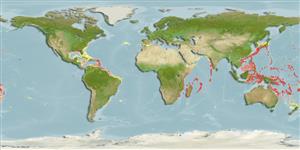Common names from other countries
Classification / Names / Names
Nombres comunes | Sinónimos | Catalog of Fishes (gen., sp.) | ITIS | CoL | WoRMS
Environment: milieu / climate zone / depth range / distribution range
Ecología
Pelágico; rango de profundidad 200 - 677 m (Ref. 116105). Temperate; 75°N - 48°S, 98°W - 175°E
Distribución
Países | Áreas FAO | Ecosistemas | Ocurrencias, apariciones | Introducciones
Circumglobal in temperate and tropical epipelagic waters.
Length at first maturity / Tamaño / Peso / Age
Maturity: Lm ? range ? - ? cm Max length : 1.9 cm BL macho / no sexado; (Ref. 2255)
Epiplanktonic to mesoplanktonic. Hypersaline specialist (Ref. 116105). Epipelagic (Ref. 116365).
Life cycle and mating behavior
Madurez | Reproducción | Puesta | Huevos | Fecundidad | Larva
Members of the phylum Chaetognatha are hermaphroditic. Mating behavior: A preliminary visual signaling behavior for species recognition is observed to prevent predation. Life cycle: Eggs directly develop into miniature adults (hatchlings).
Pierrot-Bultz, A.C. and K.C. Chidgey. 1988. (Ref. 2255)
IUCN Red List Status (Ref. 130435)
CITES status (Ref. 108899)
Not Evaluated
Not Evaluated
Human uses
| FishSource |
Herramientas
Más información
Age/SizeCrecimientoLength-weightLength-lengthMorfologíaLarvaAbundancia
Fuentes de Internet
Estimates based on models
Preferred temperature
(Ref.
115969): 8.8 - 21.1, mean 14.2 (based on 531 cells).
Vulnerability
Low vulnerability (10 of 100).
Price category
Unknown.
